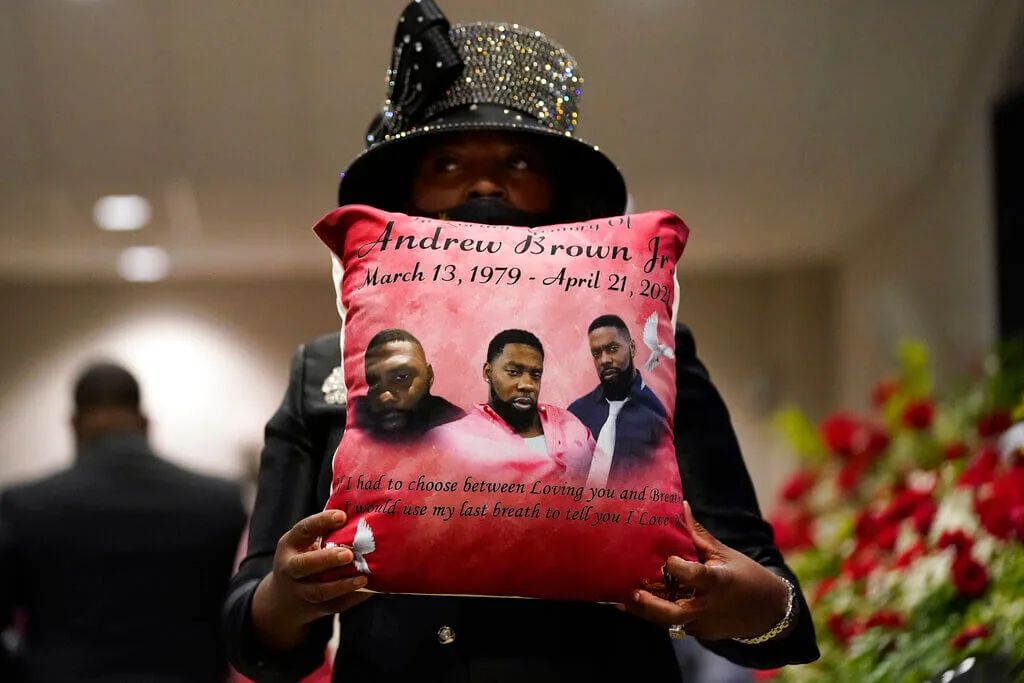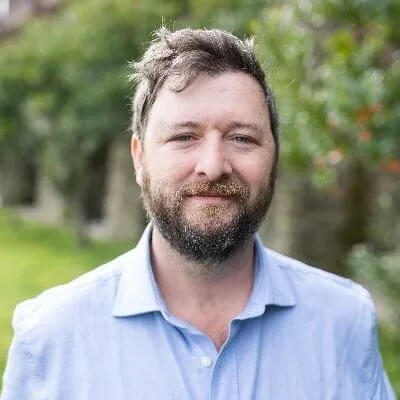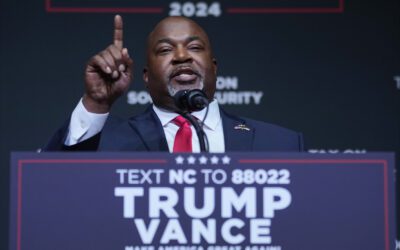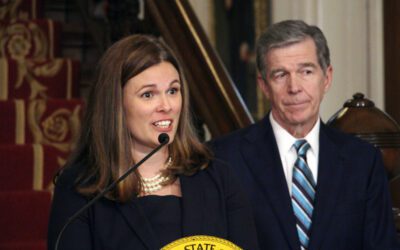
Mourners attend the funeral for Andrew Brown Jr. May 3 at Fountain of Life Church in Elizabeth City . (Image via AP Photo/Gerry Broome)
As marchers and civil rights leaders seek to humanize the man killed by deputies in Elizabeth City, it’s white folks who need to be listening.
Andrew Brown Jr. was by all accounts one hell of a pool player.
At his funeral Monday in Elizabeth City, a funeral that attracted the likes of Rev. Al Sharpton and Bishop William Barber II, his cousin Elton explained how funny the man was too.
Two months ago, when Elton’s girlfriend coaxed him into a pedicure, Elton sheepishly announced it on Facebook. Andrew was the first to comment. “Hey cuz, I’m getting my feet done too!” he boasted, posting a photo of his newly buffed toes.
We put the facts first, always. Subscribe to the free Cardinal & Pine newsletter here.
These aren’t the sort of stories we’ve heard so far about Andrew, the 42-year-old from Elizabeth City whose April 21 killing by Pasquotank County deputies made northeastern North Carolina the center of the racial justice movement this week. It’s a movement so big it feels like it can’t possibly be contained in the 11-square-mile city where my family hails from in North Carolina. Next week, or the week after, it will move on to the next town where a Black American is gunned down by police.
These simmering racial tensions in Elizabeth City, about as close to a 50-50 split in Black and white population as you’ll see in North Carolina, will still be here when the news crews go.
So will this family, left to unpack how Andrew could be justifiably shot in the back of the head by law enforcement while trying to flee arrest in his car.
To so many white folks just like me, Black men killed in stories like this might still rate just a 300-word news brief. Age, arrest record, and circumstances of death, hardly any room for empathy between the lines. No death, no inequality, should be this normalized.
The Black Lives Matter movement is as potent, as essential, as ever, but white people like me have only grown more skeptical of it, particularly white Republicans, even as research shows Black Americans are three times more likely than white Americans to be killed by police.
The FBI has opened an investigation into Andrew’s death, but state Superior Court Judge Jeff Foster ruled against a media coalition’s request to release footage of the incident last week, citing a state body cam law that excludes the footage from public records. Family members have seen an edited, 20-second snippet. An attorney for Brown’s family said the footage shows an “execution.”

It would be a crime to characterize stories like Andrew’s as tragedies. Often enough these are not tales of misunderstanding or acts of nature. They are the acts of people, mostly white law enforcement officers.
America has spent so many years dehumanizing Black people, making them cogs in cotton gins, underfunding schools in Black neighborhoods, compacting Black lives into birth and death, it seems we don’t know how to stop. We don’t make room for Black triumphs and we hardly made room for Black tragedies. It’s inconceivable white leaders would allow the same conditions for their own race, a point made again and again by state and national civil rights leaders in Elizabeth City.
“How many funerals do we have to have before we tell the Congress and the Senate that you got to do something in these times?” Sharpton asked, later referencing proposed federal legislation like the George Floyd Act, a bill expanding state and federal oversight of policing practices and limiting certain uses of force by law enforcement.
Andrew’s funeral drew several hundred to an Elizabeth City megachurch that’s typically filled with a mostly white congregation on Sundays. Cameras lined the walls and the center of the sanctuary. Sharpton’s National Action Network was there to broadcast. It was built for public consumption, choreographed just as Emmett Till’s mother demanded an open casket.

“Me and my dad, he was my best friend,” Andrew’s son, Jha’rod Ferebee, said. “Every time you seen him, you seen me. You seen me, you seen him. We couldn’t stay away from each other.”
“It’s terrible the way we have to meet together like this,” Khalil Ferebee, Andrew’s older son, said through tears. “But seeing everybody, I’m glad we’re together like this right now.”
Most of the white people at Andrew’s funeral were journalists. And even if we were meant to be there, I felt a queasy sense of voyeurism. As the pallbearers carried the casket, white photographers swarmed a little Black girl in a white dress and denim jacket who flitted back and forth between Brown family members.
It raised a question that I struggled to answer. Am I here to document, sympathize, or to gawk?
“It’s all a show!” an unidentified Black woman shouted at funeral goers, interrupting the preacher mid-prayer. “We’re the only ones who gave a damn about that man!” she screamed as ushers hurried her out the back doors of the sanctuary.
The preacher went on, almost quiescently, as if nothing had happened.
“Hallelujah,” he breathed into the microphone.

Two Sides to Elizabeth City
Andrew and I grew up not far from each other in Elizabeth City, an old shipping outlet on the swampy narrows of the Pasquotank River in northeast North Carolina. And while I went to school with his younger brother, we didn’t know each other.
That’s not particularly unusual even in a small Southern city of just 17,000. It is quintessentially American to say that Andrew and I might have gone to the same schools, ate at the same places, played on the same playgrounds. We might have gone to the same movie theater, the only one in town.
But it feels like we couldn’t have known each other.
We grew up on different sides of Elizabeth City, a place that’s a microcosm of racial division in North Carolina.
When Andrew died, he was living a short walk from the Pasquotank River waterfront and the city’s historic downtown. Many white folks here refer to these neighborhoods as “Blacktown.” Sometimes, depending on how crude the person is, they call it “Cracktown.”
Andrew’s cousin Elton also talked Monday about growing up with Andrew in the Debry projects, a brick public housing development over the fence from my elementary. Of course Elizabeth City has its share of middle- and upper-class Black residents, but many of my Black classmates in school lived there.
As a child, the neighborhood seemed forbidden, imposing, even menacing. I was a middle-class white kid. And these race and class lines seemed like immutable characteristics of my hometown, not the bitter fruit of generations of discrimination.
Andrew was four years older so we didn’t overlap much in school. I went to many classes, however, with Pasquotank Sheriff Tommy Wooten, or T.S. as we knew him. Wooten, a white man, has been pressured by local and state civil rights leaders to resign after the shooting.
But, like most things here, there are two narratives down in Elizabeth City: one for white folks, one for Black folks.
In recent days, some white locals shared a collage of Wooten on social media, playing with local children. “Lest we forget the good a man has done,” read the caption.
Wooten was a decent guy when I knew him as a child 25 years ago. He might still be. But the folks who shared these photos of Wooten tend to talk about Andrew only through his criminal record—a list of mostly nonviolent, drug-related offenses—and the way he died. The context that white folks would grant to a white person is not often granted to a Black person.
Our inequalities were not built overnight. They are the product of generations of racism. But that lack of context granted Black Americans shows itself in the way we write our laws, the way we elect our leaders and build our institutions.
Black life isn’t a monolith. It includes different racial and ethnic identities, different experiences, different values. But Black people are more likely to go to poorly funded schools with facility needs. They’re more likely to interact with law enforcement in schools. They’re more likely to live in poverty when they grow up. And if they ever face criminal charges, they’ll face harsher sentencing.
Andrew couldn’t possibly have known enough people to fill that megachurch in Elizabeth City this week, or to fill downtown Elizabeth City’s streets each night since his shooting in April. Those folks are there because they see not just Andrew’s shooting, but the inequalities for Black Americans that endure from birth to education to housing to jobs to the voting booth and, finally, to death, the inequalities that chase them like a spectre.
“To many people, this is just another Black body,” Bakari Sellers, the former South Carolina lawmaker turned racial justice advocate, said this week in Elizabeth City. “But to us, it’s a brother, father, and a nephew.”
At the conclusion of a Sunday march and rally on the steps of Pasquotank County’s public safety building, which houses the local sheriff’s office, North Carolina’s pre-eminent civil rights leader William Barber II did something he doesn’t normally do. He turned to address one person, Andrew’s son Khalil.
“Andrew Brown, let us not let America forget, was a man,” the preacher said. “Your daddy, Khalil, was a man.”
Barber might have been addressing Khalil, but the white folks in the crowd knew who Barber was really speaking to.

Support Our Cause
Thank you for taking the time to read our work. Before you go, we hope you'll consider supporting our values-driven journalism, which has always strived to make clear what's really at stake for North Carolinians and our future.
Since day one, our goal here at Cardinal & Pine has always been to empower people across the state with fact-based news and information. We believe that when people are armed with knowledge about what's happening in their local, state, and federal governments—including who is working on their behalf and who is actively trying to block efforts aimed at improving the daily lives of North Carolina families—they will be inspired to become civically engaged.


Op-Ed: Studying the Holocaust remains vital to ensuring it never happens again
International Holocaust Day will be observed on January 27, 2024. This day commemorates the liberation of the Auschwitz concentration camp by the...

VIDEO: How Rural Broadband Is Coming to This North Carolina County
More than 1.1 million North Carolinians lack access to high-speed internet, a necessity of the modern economy. In Warren County, help is on the way,...

VIDEO: Sampson County puts Biden’s promise to boost rural infrastructure to the test
Locals in this rural NC county say their water and air is polluted by a PFAS-contaminated landfill, massive hog and poultry farms, and industrial...

VIDEO: Sampson County puts Biden’s promise to boost rural infrastructure to the test
Locals in this rural NC county say their water and air is polluted by a PFAS-contaminated landfill, massive hog and poultry farms, and industrial...

Mold and classes in trailers: Inadequate funding for schools is hurting NC communities
Schools across the state are dealing with dilapidated classrooms and buildings in need of significant repair or a total rebuild due to a lack of...








